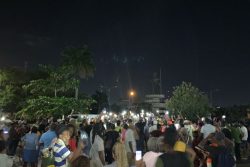Reflections on the current economic and social crisis: A gender perspective
10th W.G Demas Memorial Lecture
Tuesday May 26, 2009
Final Instalment
Professor Reddock is a distinguished Caribbean academic and the holder of
the Zeventh Caricom Triennial Award
By Rhoda Reddock
These researchers also noted that:

Some fathers totally abandoned their children, and several of the male participants expressed keen disappointment over this abandonment and the fact that they had not experienced the nuturant and supportive relationship that they felt ought to exist between a father and son. Still there were fathers who were loving and supportive although even in such cases the children felt a stronger emotional bond with their mothers. (Bailey, Branche and Henry-Lee: 2002:5).
But the male breadwinner/female housewife concept is undergirded, consciously or unconsciously, by assumptions of what we call sexual-economic exchange. In other words the assumption exists that women access financial support for tbemselves and their children through an exchange of sexual and domestic services. Where this is no longer the case – where a relationship has ended for example, many men – of all economic classes feel hard-pressed to continue with financial support. The other side of this equation is that for most women economic provision becomes the sine qua non of fatherhood. Men who do not or are unable to provide economically are prevented from seeing their children and fathering cannot be expressed in any other ways.
In an effort to change this, the draft National Gender Policy for Trinidad and Tobago, completed in 2004 as an extensive collaborative exercise involving the UWI Centre for Gender and Development Studies and the Division of Gender Affairs (5) of Trinidad and Tobago, identified as one of its policy areas – the promotion of men as parents and proposed the following policy changes:
1. Review of the practice of paternity leave in local and foreign jurisdictions to prepare draft legislation for discussion and consideration. This should include the minimum ILO recommended leave with benefits. Paternity leave should also be provided with safeguards to prevent misuse and abuse.
2. Creation of measures to increase men’s participation in the pre-natal and birthing processes.
3. Provision of support mechanisms for men who wish to be full-time home makers.
4. Increased awareness of these new understandings of fatherhood among relevant sectors of workers e.g. family court, social service delivery, school social workers, teachers, etc.
5. Strengthening the male support programme of the Gender Affairs Division to include programmes on new approaches to fatherhood in communities and workplaces.
In relation to child maintenance payment the report noted that in Trinidad and Tobago between 300-400 men are incarcerated each year for failure to pay maintenance (NGPTT,2004:73). It also noted that:
The maintenance of children is an important gender equality issue. Neither the legislation nor the way it is implemented or administered addresses the issue in a meaningful way.’ And among others the draft policy recommended the implementation of:
…new and creative remedies (such as sharing in childcare or picking up children after school to give to (sic) women employment options) and a review of the process of determining the quantum of maintenance payments (NGPTT, 2004:74).’ While young male demise – and I say demise because in my country they are dying daily- is often pitted against the improvement in the status of women, the truth is that the status of young men is closely related to the status of their mothers; something recognised by young men themselves as they stoutly defend their mothers against all who question them.
Because of the improvements in the levels of education and quality of life for women in general in Caribbean societies, the situation among lower-income or poor women seldom receives the attention it deserves.
Women are the mothers, baby-mothers, sisters, daughters, partners and lovers of these young men. They contribute through their gendered assumptions and practices towards these young men’s development. They also have the responsibility to take care of their children after they are shot down, or go into prison and to continue to support them in other ways. As noted by the Trinidadian group WINAD we recognised that, although the violence is happening among our young males, when you look closer at the problem women are seriously affected,” Women are the mothers or partners of both perpetrators and victims. They have to pay for legal representations or burials.
The women of Laventille don’t accept this burden stoically or complacently. There is strong desire to get involved in their community and bring about change. ..
“Women also recognise that they have a central role to play in alleviating the problem, but that there needs to be some sort of mobilisation.” (Interview with Folade Mutota, Daily Express, 11.9 2004)6
Masculinities and Violence
In many contexts masculinities are associated with violence, violence as protection, defence or as a mechanism for gaining and preserving power. As noted by WINAD (2006), although violence is not strictly a practice of men, it is linked to masculine identity. In a 2004 document – The Costs of Male Violence, a group of seven masculinities studies scholars observed that violence may thus comprise the single largest outlay of public and private funds in any society for legal adjudication, punishment, health related costs – as well as indirect costs through reduced productivity, increased absenteeism, and the many and long-term effects on children exposed to violence. The overwhelming majority of violent acts are committed by men, at every level – between individuals, within and among groups, and within social institutions. These acts of violence are committed not only against women and children, but also against other men (Ferguson, Hearn, Holter, Jalmert, Kimmel, Lang and Morrell, 2004:7). They note that men’s violence is a problem for men as from childhood; boys and men are exposed to violence, are its main victims, its witnesses, and expected to be its perpetrators. They conclude therefore that it is men who have the responsibility to end men’s violence and it is men who have much to gain by doing this (Ferguson, Hearn, Holter, Jalmert , Kimmel, Lang and Morrell, 2004:9).
But violence, be it domestic violence in the household, peer violence and teacher violence in schools, (and I understand that schools can be extremely violent spaces for children and this is something that we need to consider seriously in this region as school violence is one reason boys drop out of school), or gang, criminal or police violence on the streets, violence is an ever present characteristic of our lives. Indeed research suggests that while women and girls are more at risk of violence within the home, men and boys are more at risk outside the home. In other words the very spaces designated as women’s and men’s spaces are the sites where they are most at risk for violence (Ferguson, Hearn, Holter, Jalmert, Kimmel, Lang and Morrell, 2004:22).
This normalised pattern of violence was heightened during the period of economic neoliberalism as mentioned earlier.
Violence, Consumerism and the Globalised US Media
But violence is an ever present component of contemporary life. Indeed today’s entertainment industry – television, video games, cinema and the internet appears to me to be modern globalised high-tech versions of earlier forms of violent entertainment such as the christians and the lions and public hangings. While on the one hand this suggests that the human psyche may have a natural appetite for blood and gore, the influence of globalised images and musical representations of male violence – in particular black male violence -have served to normalise and valorise male violence and the gun as the weapon of choice and phallic identification.
But the globalised media beamed into all of our territories is guilty of other crimes. These include the focus on young female hypersexuality and the increased commodification of their bodies and sexualities; the generalisation of conspicuous consumption and the emergence of ‘brands’ and ‘bling’ as markers of social status and bases of ‘respect’. It has also been the major purveyor of the ‘get rich quick or die trying’ mentality, which is directly linked to the consumerist imperatives mentioned before.
The ‘global’ media plays a critical part in highlighting economic disparities. Consumers in the economic south become closely aware of the consumer items which they do not own and this increases demand as well as feelings of deprivation. Preceptions of unfulfilled entitlement are generated among youthful populations, bred on a diet of commodity consumption demand fed by US commercial cable television and the US commercial internet. Perceptions that they are worst off than others is a powerful instigator of violence and engagement in criminal activity for financial gain.
For countries of the African diaspora and people of colour everywhere, this influence has been particularly strong as transmissions of commercialized US Black culture through television, music videos, the internet and the recording industry generally has a significant influence on diasporic populations the world over including Africa, a responsibility not often recognised by the artistes themselves in their quest for economic success in a market-driven world and certainly not the concern of the corporations. In his book Manufacturing Powerlessness in the Black Diaspora, Charles Green (2001) links the urbanizing effects of global capitalism to the environment of failure and despair characterising Black youth, in particular male youth in the African Diaspora who cannot be reached by local education and other programmes.
Conclusions: What now for Caribbean People and their Governments?
In conclusion, this period of crisis should also be seen as a period of opportunity. It provides the opportunity for critical reflection, review and renewal. As Caribbean leaders let us not wait for the signals from the North to tell us what we need to do; let us take the bold steps to chart a new way forward. In the short run we may ask ourselves – What would a Caribbean stimulus package look like? In speaking about the role of new Caribbean societies Demas suggested that the first priority must be to meet the basic needs of all the people in the society for work, food, shelter, clothing, education and recreation, and to ensure that these goods and services are equitable distributed (Demas, 1965).
I want to endorse this suggestion that we focus on our people but probably in more sophisticated ways than we have in the past. We also need to re-orient the focus of the people on the region as for the last two decades it has been directed elsewhere. They need to once again see themselves as Caribbean people, citizens of a region with a clear vision of where it needs to go and that they want to be part of.
We need to support parents, families and households in a gender-sensitive way – whatever their shape or composition to meet the increasingly difficult challenges of parenting in a globalised world. The Nordic countries, for example, have incorporated gender equality and family-friendliness into their socio-economic paradigm and guarded this jealously during the period of economic liberalism, with little loss to economic growth or competitiveness as observed by The Economist in 2006:
The Nordic region * …+ has the world’s highest taxes and most generous welfare benefits. And yet Sweden, Finland and Denmark (Norway’s oil sets it apart) have delivered strong growth and low unemployment, and rank among the world’s most competitive economies. Nordic companies are strong in technology and research and development. Their health-care and educational systems are much admired. And, unlike other European countries, most Nordic states run healthy budget and current-account surpluses. Sweden, whose 9 million people make it by some way the biggest Nordic country, is a particular favourite. A year ago The
Guardian, a British newspaper, said it was the most successful society the world had ever known.’ The Economist (2006).
In these countries the burden of care is shared with the state, all of which have instituted non-judgemental national parenthood policies, which are monitored and updated as changes in parenting situation emerge. Ellingsreter and Amlaug note that from the 1970s, the Nordic countries have set new standards for ‘good’ motherhood and fatherhood, facilitating caring fatherhood, working motherhood and a more equal sharing of breadwinning and caring… Welfare policies have advanced and facilitated the sharing of earning and caring, forwarding a model of the, citizen-parent – mothers and fathers who combine employment and childcare (Ellingsreter and Amlaug, 2006:47).
Childhood is recognized as a pivotal period for children’s development, therefore, education is gradual, child-centred and based on evidenced-based research on child development. At the UWI we are also carrying out research in this area. These states also recognize lone parenting as a reality and provide support systems to address this. Although these systems are not perfect they suggest that there is no contradiction between supporting people’s needs in a gender-sensitive and progressive manner and economic growth. Of course, these supports are the result of high taxation but citizens benefit from the reduced stress and relative safety and security of their lives.
This suggests that our education system, which, in some instances, has focused primarily on qualification and certification and not on real learning, needs to be totally re-conceptualised. We need a system that empowers, transmits knowledge, skills and awareness and facilitates social, civil and regional engagement.
We at the University of the West Indies hope to take leadership in this direction in the future and ask for your support in this area. To achieve this, an understanding of gender must be central.
Teachers, social workers and guidance officers all need to be trained in gender analysis to a high level in order to address some of the issues raised in this presentation.
This region also needs to take a much more considered approach to its media policy. In these days of unregulated free trade, with still surviving WTO rules this is discouraged but in this new context, how do we build on the creativity of our artists, film makers, writers, crafts people and media practitioners to develop a regional media and cultural industries that bring to the fore all that is best in us. How can our media link us with the rest of the region and the global south?
Connecting us more closely with Latin America, the African sub-continent and Asia, how can we diversify our media products to facilitate a truly globally aware Caribbean citizen? How can our most creative sons and daughters be able to live, work and share their knowledge in the region and not have to migrate in order to survive? Here I would like to echo the call made by one of my predecessors Professor Rex Nettleford when in his W.G. Demas Memorial Lecture he called for initiatives to unlock the creative potential of the inhabitants of the region, noting that, …for future Caribbean society to be worth its salt, it must shape itself into a society that can facilitate, to its optimum, the exercise of its people’s creative intellect and creative imagination, the fruits of which will be the only reason for our existence and our endurance in the recorded history of human civilisation. (Nettleford,2004:23).
We owe it to those who went before and struggled for a Caribbean sensibility, for our sons and daughters struggling for a sense of identity and for meaning in their lives. At the UWI we will be striving to play our part in this regard and ask for your support in this endeavour; but I end by asking – What now for the Caribbean Development Bank at this historic conjuncture? What now for Caribbean leaders and their governments?
I thank you.
References
‘About the Great Depression,’ Modem American Poetry Website http://www.english.illinois.edu/maps/ depression/about.htm Accessed 7, April 2009.
Andrews, Erline (2004). Aiming for Change, Interview with Folade Mutota, founder of WINAD, 11, July, Trinidad Express, http://www.trinidadexpress.com/index.pl/article _ archive?id=29314869 accessed 15, April 2009.
Best, Lloyd (1998). William Demas: West Indian, Trinidad Express, 30, November, p. 13.
Bailey, Whilma, Clement Branche and Aldrie Henry-Lee (2002). “Gender, Contest and Conflict in the Caribbean: Lessons from Community-based Research”, Kingston, Institute of Social and Economic Studies.
Brown, L. (1994). Crisis, Adjustment and Social Change: The Middle Class Under Adjustment,’ In Elsie Le Franc (ed.). The Social Consequences of Structural Adjustment:A Review of the Jamaican Experience, Canoe Press, Kingston, pp. 56-118. (Cited in Cain, 2008).
Buvuni Mayra and Andrew R. Morrison (2000). Living in a More Violent World’, Foreign Policy, No. 118, Spring.
Cain, Maureen (2008). ‘Criminogenesis and the War against Drugs: (Another) Story of Absented Women’ in Maureen Cain and Adrian Howe (eds.) “Women, Crime and Social Harm: Towards a Criminology for the Global Era” Onati International Series in Law and Society, Oxford, Hart, Publishing pp. 21-36.
Colonial Office (1955). Colonial Development and Welfare Acts, Reports on the Administration and Use of the funds provided under the Colonial Development and Welfare Acts, Presented by the Secretary of State for the Colonies, January, H.M.S.O. Cmd. 9375.
Crabtree, Vexen (2006). “Scandinavia, the Crown of Civilisation: Sweden, Denmark, Norway, Finland and Iceland’ http://www.vexen.co.uk/countries/scandinavia. html, accessed on 23, May 2009.
Demas G. William (1965). The Economics of Development in Small Countries with Special Reference to the Caribbean, Montreal, Mc.Gill University Press
Ellingsreter, Anne Lise and Amlaug Leira (2006). Introduction to Politicising Parenthood in Scandinavia: Gender Relations in Welfare States, London, Polity Press.
Ferguson, Harry, JeffHeam, 0ystein Gullvag Holter, Lars Jalmert, Michael Kimmel, James Lang and Robert Morrell(2004). Ending gender-based violence: A call for global action to involve men: A summary of research, SIDA, Sweden.
Figueroa Mark (2004). ‘Male privileging and Male’ Academic Underperformance’ in Jamaica’, in: Rhoda E. Reddock (ed.) Interrogating Caribbean Masculinities: Theoretical and Empirical Analyses, Kingston, The University of the West Indies Press.
Johnson, Howard (1977). ,The West Indies and the Conversion of the British Official Classes to the Development Idea’ Journal of Commonwealth and Comparative Politics, Vol. XV, No.2
Girvan, Norman (2009) The Caribbean in a Turbulent World’ Keynote Address, Colloquium The Western Hemisphere: Beyond the Summit of the Americas, Institute of International Relations, The University of the West indies, S1. Augustine Campus, April 14.
Charles Green (2001). Manufacturing Powerlessness in the Black Diaspora, Inner-city Youth and the New Global Frontier, Altamira Press, Walnut Creek.
Levitt Kari (2005). Reclaiming Development: Independent Thought and Caribbean Community, Ian Randle Publishers, Kingston Lewis, W. Arthur (1977). Labour in the West Indies (first published in 1939) New Beacon BODks, London.
Nanda, Serena (2000). Gender Diversity: Crosscultural Variations: lllinois, Waveland Press.
Nettleford, Rex (2004). “Re-engineering Caribbean Cultural Enterprises/Institutions: Agenda for the Future”; The William G. Demas Memorial Lecture, hosted by the Caribbean Development Bank, Tobago, May 11.
Plummer, David and Joel Simpson, (2007?). ‘HIV and Caribbean Masculinities’, HIV Education Unit, School of Education, The University of the West Indies, S1. Augustine Campus (mimeo).
Reddock, Rhoda (1988). Women, Labour and Politics in Trinidad and Tobago: A History, Zed Books, London and Ian Randle Publishers, Kingston.
Reddock, Rhoda (2005). ,Women Workers Struggles in the British Colonial Caribbean: the 1930s’, in Constance Sutton (ed.) Revisiting Caribbean Labour: Essays in Honour of Nigel Bolland, Kingston, Ian Randle.
Reddock Rhoda and Bobb-Smith Yvonne (2008). ‘Reconciling Work and Family: Issues and Policies in Trinidad and Tobago’. Conditions of Work and Employment Series, No.18.
International Labour Organisation, Geneva, International Labour Office.
The Economist (2006) article “The Swedish Model” cited in Vexen Crabtree, Scandinavia, the Crown of Civilis at ion: Sweden, Denmark, Norway, Finland and Iceland’ http://www.vexen.co.uk/countries/scandinavia.html, accessed on 23, May 2009.
The University of the West Indies, Centre for Gender and Development Studies, and Gender Affairs Division, Ministry of Community Development, Culture and Gender Affairs, Trinidad and Tobago (2004) National Gender Policy and Action Plan for Trinidad and Tobago, (draft).
UNAIDS, (2008). Despite Progress, AIDS-Related Illnesses Remain Leading Cause of Death Among People Ages 25-44 in Caribbean,’ 20, June.
http://www.kaisemetwork.org/daily Jeports/rep _ hiv Jecent_rep.cfm?dr _ cat= 1 &shodDateTime= 06-20-08#52850
United Nations Office on Drugs and Crime(UNODC) and The World Bank (Latin America and the Caribbean Region)(2007). Crime, Violence, and Development: Trends, Costs, and Policy Options in the Caribbean, Report No. 37820 , March.
Wicker, E.R. (1958). Colonial Development and Welfare: 1929-1957: The Evolution of a Policy,’ Social and Economic Studies, Volume 7, No.4, pp. 170-192.
WINAD (Women’s Institute for Alternative Development)(2006). A Human Security Concern: The Traffick, Use and Misuse of Small Arms and Light Weapons in the Caribbean. (mimeo).









